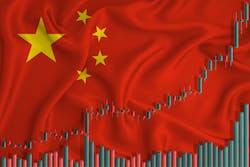Surviving the emerging new order within the Chinese laser market
During his 2022 LPMS presentation, Dr. Bo Gu, president and CTO of Bos Photonics, gave an overview of the Chinese laser market and advice to help multinational companies navigate recent changes.
“The Chinese laser market grew at 18.3% in 2021, and 10% in 2020, and reached $12.9 billion in 2021 with strong growth in laser cleaning, welding, additive, micromachining, and medical markets,” Gu says.
The Shanghai Stock Exchange STAR Market, a science and technology equities market, is helping catalyze the Chinese laser industry to make it more competitive globally.
Chinese laser industry segmentation
China now has more than 170 large-scale laser manufacturers—with 56% of them in laser materials processing and the lasers and laser systems business. In 2021, the Chinese laser market reached $12.9 billion, with an annual growth rate of 18.3%.
The industrial laser market segmentation in 2021 (see figure) was split into cutting (40%), welding (14%), marking (13%), semi/display (12%), precision machining (9%), non-metal processing (7%), and all others (6%).“Laser technology has become the key for many manufacturing energy industries to improve quality and reduce costs to help improve the industry’s competitiveness and to transition to a high-tech industry,” says Gu. “China has a complete laser industrial chain now—from components to devices to lasers to systems—and huge end-user markets.”
Chinese fiber laser market
The Chinese fiber laser market has increased 15% to $1.7 billion since 2020, and the domestic industrial laser market dominated by fiber lasers continued along a good development trend.
The top four Chinese fiber laser companies are IPG Photonics, Raycus, Max Photonics, and nLight, which account for 80.6% of the market.
“Shipments of continuous-wave (CW) fiber lasers above 6 kW increased significantly, and shipment of higher than 10 kW also experienced explosive growth,” says Gu. “Chinese-made fiber lasers accounted for $1.03 billion or 38.2% of global fiber laser revenue.”
Lasers/photonics became ‘darling’ of capital market in 2021
Hot areas of investment in 2021 included quantum photonics, industrial lasers, lidar, optical chips, optical displays, and precision optics.
“In 2021, a total of 26 financing events took place within the laser/optics field, of which 13 disclosed financing amounts of more than 100 million yuan (more than $15 million),” Gu points out. “ The portion of investment in the industrial laser field is higher, which reflects growth.”
“Strong capital injection will undoubtedly shorten these SME’s growth cycle,” he adds, “and some could rapidly grow into a unicorn within the industry.”
Chinese industrial laser outlook
The Chinese Ministry of Industry and Information Technology has issued guidance “requiring the expansion of automobile consumption, the promotion of usage of new equipment and advanced medical equipment, and the cultivation of internet-based consumption,” says Gu. “These policies will effectively promote the sustainable and stable development of industries such as industrial laser equipment, lidar, medical lasers, laser chips, and components.”
Local governments are paying attention to the laser industry and making efforts to attract laser business and investment to help upgrade their local economy or enable the downstream industries within their regions.
“One way to do this effectively is to set up a laser industrial park to build a cluster, and to provide support for the local industrial chain,” Gu notes. “This has significant advantages for the laser business, so expect to see many such laser parks set up during the 14th Five-Year Plan period.”
Chinese economic development
Around 2011, China reached the “Lewis turning point,” which happens when surplus rural labor is fully absorbed into the manufacturing sector.
“Now, China is turning to what’s called the engineer dividend, because every year China produces 6 million college graduates with STEM degrees out of a total of 10 million,” says Gu. “This is about 6X the number the U.S. graduates.”
China has a total of 100 million engineers, he adds, which gives Chinese companies a huge competitive advantage in R&D costs over their overseas counterparts.
“And contrary to early 2020 expectations, when COVID-19 briefly closed a large part of China’s economy, 77.1% of the U.S. companies within China reported profits last year, in line with the past several years,” Gu says.
Navigating turbulent conditions
Gu encourages adopting a “China plus one” supply chain model to increase agility and resilience by diversifying.
“In China, for China” is a way of localizing products designed specifically for the Chinese market. “Formulate a multiyear strategy for product localization based on the company’s competitive advantages over alternative products,” Gu recommends. “Take advantage of ongoing Asian regional integration.”
Also, recruit more local talent—set up factories in China to ensure access to the local market to serve the Chinese markets as well as the neighboring countries.
“Win the trust and support of the local government,” Gu recommends. “Have a dedicated person or team to deal with constant regulation changes and to fully understand areas supported by the government.”
While he sees new opportunities in China for companies based in Europe, Japan, and other regions, “in the long run the process of decoupling will affect every company,” Gu cautions, “so begin now to lay the groundwork for localization by adjusting your supply chains, products, customer base, and organizations.”
Adapting now “can help mitigate risks and put you in the most advantageous position to gain a competitive edge, no matter how the U.S.-China relationship plays out,” he says. “Abandonment or withdrawal will never be a winning strategy.”
CONTINUE READING >>>
About the Author
Sally Cole Johnson
Editor in Chief
Sally Cole Johnson, Laser Focus World’s editor in chief, is a science and technology journalist who specializes in physics and semiconductors.


